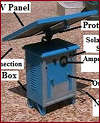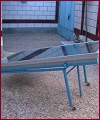Educations
● Ph.D., Mechanical Engineering
Sharif University of Technology, Tehran, Iran, 1999
● M.Sc., Mechanical Engineering
University of Michigan, Ann Arbor, Michigan, USA, 1979
● B.Sc., Mechanical Engineering
Sharif University of Technology, Tehran, Iran, 1975
Publications
ISI Journals
● Behzadi-Sarok, M., Saidi, M.H., Shafii, M.B., Design and off-design analysis of a heat pump assisted humidification-dehumidification (HDHHP) desalination system for a wide range of salinities, International Journal of Refrigeration, Vol. 171 (2025) 147-164.
● Badri, M., Saidi, M.H., Transient simulation of an integrated solar gas turbine equipped with hydrogen energy storage and hydrogen-fueled combustion chamber for continuous power supply, International Journal of Hydrogen Energy, Vol. 103 (2025) 349-364.
● Saidi, M.H., Razaghi, R., Zabetian, M., Experimental and analytical investigation of micro-particle velocity domain and particle-wall interaction in microchannel, International Journal of Nonlinear Analysis and Applications, Vol. 15(6) (2024) 173-186.
Conference Papers
● Farizan, Asadi, M., A., Abbassi, A., Saidi, M.H., Zabetian, M., Eslami, J., Experimental investigation of the effect of exhaust location on airflow patterns in a small scale room, 28th Annual International Conference of Iranian Society of Mechanical Engineers (ISME2020), Amirkabir University, Tehran, Iran, May 27-29, 2020, (In Persian).
● Farizan, A., Abbassi, A., Saidi, M.H., Zabetian, M., Eslami, J., Numerical investigation of the effect of the motion of a nurse on airflow patterns in a protective isolation room, 28th Annual International Conference of Iranian Society of Mechanical Engineers (ISME2020), Amirkabir University, Tehran, Iran, May 27-29, 2020, (In Persian).
● Alishiri, M., Saidi, M.H., Investigation of the optimal concentrations of Iron oxide-multiwalled carbon nanotubes nanofluid based on the non-dominated sorting genetic algorithm-II, 28th Annual International Conference of Iranian Society of Mechanical Engineers (ISME2020), Amirkabir University, Tehran, Iran, May 27-29, 2020, (In Persian).
Books and Book Chapters
● Sharifzadeh, M., Chen, W., Triulzi, G., Hu, M., Borhani, T.N., Saidi, M., Krishnan, V., Ghadrdan, M., Qadrdan, M., Zhao, Y., Mohammadzadeh, A., Naghibzadeh, S.K., Saidi, M.H., Rashtchian, D., Shah, N., Design and operation of solid oxide fuel cell systems: challenges and future research directions, Chapter 15 of the book titled: Design and Operation of Solid Oxide Fuel Cells, pp. 445-463, 2020, ISBN 978-0-12-815253-9.
● Mohammadzadeh, A., Naghibzadeh, S.K., Saidi, M.H., Sharifzadeh, M., Mechanical engineering of solid oxide fuel cell systems: geometric design, mechanical configuration, and thermal analysis, Chapter 3 of the book titled: Design and Operation of Solid Oxide Fuel Cells, pp. 85-130, 2020, ISBN 978-0-12-815253-9.
● Saidi, M.H., Talaei, M.R., Thermal Power Plants, (In Persian), Yazda Publisher, 1st Ed. 464 pages, 2009, ISBN 978-600-5549-19-5.
Patents
Instant Soldering Machine with Solar Hybrid
 Inventors: Saidi, M.H., Kavoosi balootaki, H., Kavoosi, E.
Inventors: Saidi, M.H., Kavoosi balootaki, H., Kavoosi, E.
Abstract:
One of the fundamental problems and drawbacks of existing soldering devices, including electric irons, is the consumption
of 60% of the electrical energy, low performance speed and efficiency, and short lifespan. This is because in these devices,
a considerable amount of energy and time is only spent on preparing and heating up the soldering device, even during the periods
when the electric iron is not in use in the soldering process. Therefore, the process should be kept active during the operation, which
leads to a significant increase in energy consumption and a decrease in the lifespan of the soldering device. Additionally,
there is no possibility of multi-purpose usage or exploiting the device in areas where there is no access to city electricity.
Using non-consumable electrodes and hybrid solar energy with AC/DC currents, a device has been created that performs
three soldering processes of hard, soft, and cutting for all materials up to a melting temperature of 1100 degrees
Celsius instantly. The photovoltaic panel absorbs 100 watts of solar energy and converts it into electricity,
which is stored in a 12-volt electrical source. By increasing the current intensity through a non-consumable carbon electrode,
it is used to perform the melting and cutting soldering processes. The design of this device allows us to use three
sources of solar energy, AC city electricity, and DC electricity produced by a car. Its use in various conditions, including areas
without city electricity, has become possible.
Combined Collector for Co-generation of Solar Heat and Power
 Inventors: Saidi, M.H., Kavoosi balootaki, H., Kavoosi, E.
Inventors: Saidi, M.H., Kavoosi balootaki, H., Kavoosi, E.
Abstract:
One of the fundamental problems and drawbacks of existing collectors is the inability to simultaneously produce
electricity and heat, the inability to transfer heat to two working-fluid media, more than 50% decrease in efficiency at
high operating temperatures, the incapability to use them for multiple purposes, and the inability to have both high
efficiency and high temperature parameters simultaneously, leading to more than 40% heat losses in thermosyphon systems,
increased costs, and required space.
Using the idea of a multi-purpose collector with a heat pipe technique, phase change oscillation, and vacuum insulation
with hybrid photovoltaic panels, a micro solar system has been created that can simultaneously produce electricity, heating,
and coling while allowing for multi-purpose use and heat transfer to two working-fluid media. It is possible to operate three solar
systems simultaneously with maximum efficiency and minimum cost and required space for all areas, including those without
access to city electricity and gas. The heat pipe oscillates between the condenser and evaporator sections and transfers
the absorbed solar energy in the evaporator section to the working fluid in the condenser section through a nanofluid phase
change process. At the same time, adjustable photovoltaic panels produce the required electrical energy while the lower part
of the panel absorbs and transfers heat to the second working fluid through embedded triangular and rectangular channels.
This design allows the multi-purpose collector to work as a micro solar system and enables simultaneous operation of three
solar systems with maximum efficiency and minimum cost and required space for all areas, including those without access to city electricity and gas.
Image Gallery
Click here to see my image gallery.

